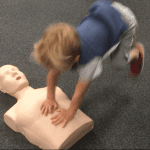I know CPR, can I help? The answer is YES. And without immediate bystander CPR, the Sudden Cardiac Arrest victim has very little chance of survival.
But, what if the person is not in Cardiac Arrest and CPR is not needed? What if they have severe bleeding, broken bones, burns, and severe allergic reactions, trouble breathing or any number of other emergencies? Here are few statistics to help put things in perspective.
- Cardiac Arrest-Over 350,000 Cardiac Arrests happen outside the hospital each year.
- Severe Bleeding-Over 60,000 Americans and almost 2 million worldwide die from blood loss each year.
- Broken Bones-Over 6 million broken bones occur in the US each year.
- Allergic Reactions-Over 200,000 people require emergency medical treatment in the US each year.
- Respiratory Emergencies-Over 3.5 million patients with respiratory emergencies are seen in US Emergency Departments each year.
These are just a few of the topics covered in a Basic First Aid class. For the lay provider just walking down the street, it’s a simple evaluation to see which one you need.
If they are not breathing or breathing normally, start CPR.
If they are breathing, it’s Basic First Aid. You may need a number of hands-on or evaluation skills.
Basic First Aid classes are readily available and often taught in conjunction with CPR classes. A lot of people think it is just about Band-Aids and Boo-Boos. The numbers don’t lie. CPR will always be needed when the patient stops breathing and their heart stops beating. Knowing Basic First Aid will also help you identify potentially life threatening problems and prepare you to help as needed. Identifying and helping a person in need may avoid the need for CPR.

